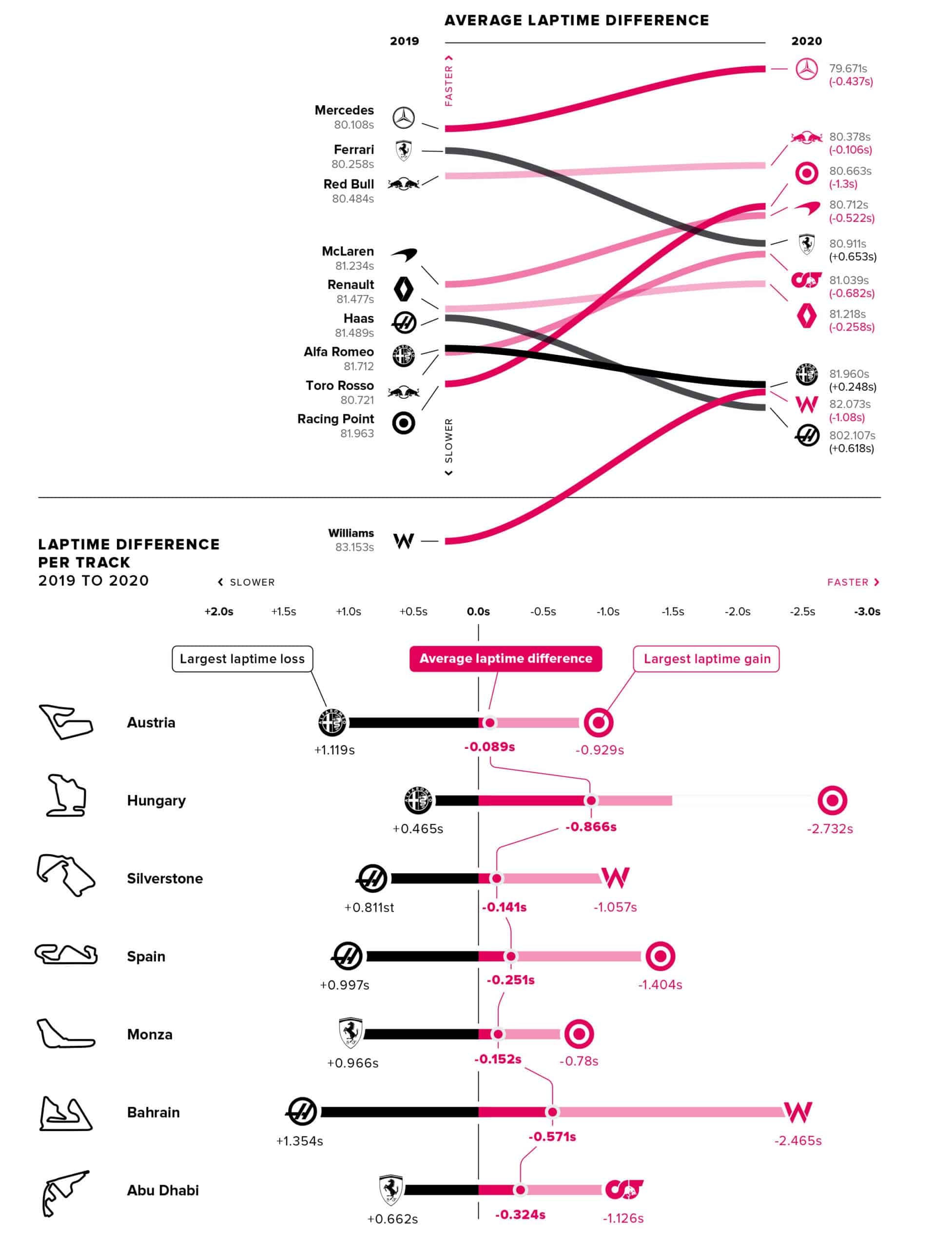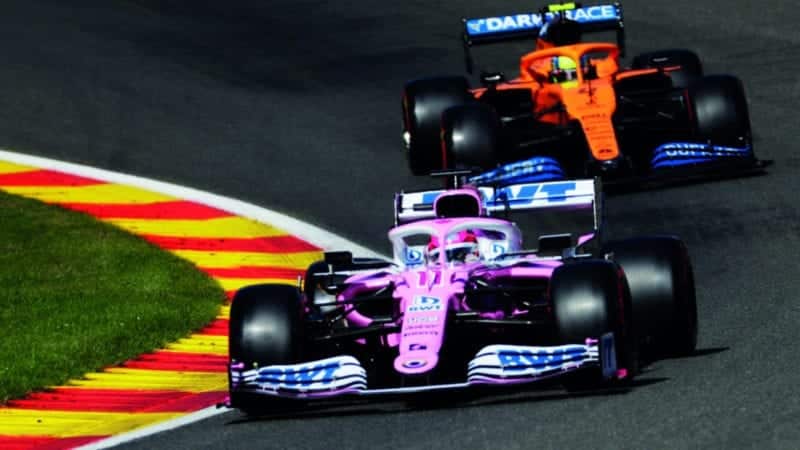Tracking Formula 1's pace setters
Seven out of the 10 grand prix teams made steps forward in pace during 2020. Here, using data recorded from the seven circuits that offered direct comparisons between 2019 and 2020, we reveal exactly how much change each team experienced. While Mercedes was well clear in the pecking order, its rate of advancement was comparatively small up against some of the midfield teams, which found big strides.
The implication is that the nose was so narrow that there was difficulty in keeping the vortices of each side from interfering with one another, thereby reducing the effectiveness and consistency of the barge boards’ contribution to the underfloor performance. This was particularly the case at low speeds – and frequently the car would spin in such corners, even when the setup gave an understeering trait in fast corners. The car was developed more than any other through the season and by the last two races was extremely competitive. But it had taken all season to get it there and Mercedes had switched off its development in September.

By contrast, the Red Bull junior team AlphaTauri stuck with the old wide-nose concept – together with a more inboard-loaded front wing – and reaped the benefits. The car showed great improvement over its quite similar predecessor and the gap between Red Bull and the junior team was halved. Technical director Jody Eggington explains: “The front wing just kept delivering development gains for us all down the car. We just kept taking the gains and re-optimising. So we’d do a new endplate, a new flap, new mainplane etc, just kept chipping away at it. The gradients in the tunnel were nice but nothing that got us fantastically excited, just little and often. That seems to work quite well for us.”
Evolution vs copying
“The planning stage for the 2020 car was the first time since the new regs in 2017 where we could actually afford to do a different car rather than just tweak what we already had,” says Racing Point’s tech director Andy Green. In what was set to be the final year of these regulations before the all-new aero regs came into force, Green – tired of hearing the same driver complaints of the car for three straight seasons – decided to take the gamble of abandoning the old concept and going full-on Mercedes copy, given that the team was already taking the whole rear end from Mercedes. The 2020 Racing Point RP20 was visually almost identical to the 2019 Mercedes W10.

The ‘Pink Mercedes’ proved a revelation for Racing Point
Getty Images
But just taking on another team’s design creates all sorts of missing understanding, as Mercedes’ James Allison explains: “One of the things that perhaps Racing Point deserves more credit for is a) the courage that they showed in doing it and b) the competence with which they’ve done it, because they’ve done a good job in making that leap.”
Green talked pre-season about the process of understanding the low-rake Mercedes. “We started looking at different attitude in CFD to understand where you’re losing compared to a high-rake car, and where you can gain, because it’s a trade in the two. And from that, let’s try to understand what they’ve been doing with it… the first thing you understand is: ‘crikey, we’ve got no front load on the car. We’ve taken a pinch out of the car, and suddenly we’ve lost 40 points of front load that needs recovering’. You start to move in that direction. You start developing your front wing and start looking at how has Mercedes got round this big reduction in front load. We looked at their front wing, at the way their flow structures pass over and around the front wing. And it was very different from the way that we had done it in the past, with the strake arrangement now in front of the front tyres.” The process of understanding gradually moved down the car from there.
“We made big, bold decisions early and gave the design team strict constraints”
The gains were spectacular, in that the team found 1.3sec over its 2019 car at these seven tracks. But comparing the 2020 Racing Point average with that of the ostensibly very similar 2019 Mercedes, it can be seen that the pink car trails the silver one by an average of 0.55sec. How much of that is down to driver differences, how much to team knowledge and how much to random factors is an unknown. But some combination of the three.
How Williams progressed
Emphasising the point made by AlphaTauri, Williams found a lot of performance (1.1sec) between 2019 and ’20, despite an ostensibly very similar-looking car.
Chief engineer Adam Carter explains what was behind this: “Fundamentally the core architecture of the car was not the problem. So we held on to that so we could maximise the resource investment into the areas that we thought were our performance opportunities, our true hotspots.
“Having the architecture locked down earlier allowed us to do a lot more design iterations, and then we had a healthy development rate in the tunnel. So more design loops, more structural efficiency loops, packaging detail, etc. If you look at the FW43’s packaging underbody, the car is exceptionally clean; all the underbody aerodynamics, the packaging detail on it, the wishbone structural efficiency, the detailing around the front uprights, etc. The guys and girls in the design team have done an absolutely exceptional job there and that also comes from making big, bold decisions early and giving them known constraints to work in and then let them go at it and get it into that. Also, if you get the detail right at design level, you get the detail then delivered at manufacturing as well.”

Same basic architecture, far better execution. Williams made huge gains over its disappointing 2019 car
Grand Prix Photo

